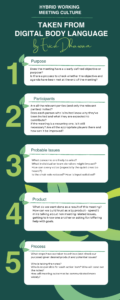
How many Zoom/Teams/Skype/FaceTime calls have you had today?
I have had 7 so far, and I am not yet finished for the day. There are days when it’s 20 or more.
My toolbar is now filled with the various icons to connect digitally and remotely and I know I am not alone. Often there’s barely time for a comfort break between meetings, let alone lunch or time to actually recharge the brain.
So, it is no surprise that according to the latest research, our online lives have changed considerably (and perhaps forever) over the past two years.
Some stats:
- Time spent attending Teams meetings has increased by 252% since February 2020.
- There are 150% more meetings.
- 32% more “chats” per person.
- And worryingly, more than 27% more after hours work and an increase of 13% on the average workday span.
- The craziness of this all has led to a few fails along the way – although the cat video still makes us laugh.
Where hybrid work fits into all this
Although some research shows that 50% of employers say they plan to require full time, in person work, there are also employers who have disbanded the requirement for any office at all.
The truth, as they say, will probably be somewhere in between – with a hybrid arrangement. But rather than “working from home” being a laptop plugged in at the kitchen table: to make hybrid work actually work, it needs to be intentional and planned. And with so many meetings taking place, this means having an excellent hybrid meeting culture.
What does intentional look like when it comes to online meetings?
The excellent book, Digital Body Language by Erica Dhawan (required reading in the post pandemic era) suggests the 5Ps.
- Purpose – what’s the objective of the meeting. Is it clear to everyone?
- Is there an agenda? Has it been sent in advance?
- Participants -are all the relevant parties (and only the relevant parties) invited?
- Does each person who is invited know why they’ve been invited and what they are expected to contribute?
- Probable Issues – What concerns are likely to arise?
- What individual or team derailers might impact?
- Are there overlapping or back to back meetings?
- How focussed are people on what is being discussed?
- Does the tech work? If connection/speakers are an issue- how can that be improved? How can we limit echoes and reduce lags?
- Does the meeting time work for all (ie – is it way out of hours for some)?
- Product – what do we want done as a result of this meeting?
- How can we build trust as a by product – can spend 5 mins talking about non meeting related issues, getting to know one another or asking for/offering help with goals.
- Process – What steps have we taken to achieve (and check our purpose) given desired product and potential issues?
- If the meeting is a recurring one, is it still necessary? Are all the appropriate players there and how can it be improved?
- Can we do a two work check in (as per Brene Brown)
- How can every voice (especially the quiet ones be heard?)
- Is there a chair? Is there a moderator (if relevant)? Is the chair role rotated?
- Has an appropriate ‘acknowledgement of country’ or other undertaken?
- How are different languages accounted for?
- How is input solicited (polls/quizes/whiteboard/breakoutrooms)?
- Have documents been sent in advance?
- Are cameras on and phones put away?
- Is everyone aware of raising hand/other etiquette?
- Can we start at 05 or 10 past the hour to give brains a break, and allow for a toilet break etc?
- Who is taking notes?
- Who is responsible for each action item?
- Who will send out notes?
- Who will communicate meeting outcomes?
- Who will keep those who couldn’t attend in the loop?
- If it’s a mixed meeting (virtual/IRL) – are we being intentional about checking in with everyone?
The Takeaway
We can do online meetings well.
It’s as easy as considering the 5Ps in your meeting practise and including them as part of regular meeting etiquette.
Ignore the above at your peril though. Wasted time. Disengaged employees. Reduced productivity. And possibly more zoom fails of the less amusing kind.
More Resources..
Virtual Meetings a Pain – HR Daily
Want more still…….
If the above has whetted your appetite, and you’re keen for more.. Here are some ideas:
Does leadership interest you? You can sign up to my FREE seven day “Be a Better Boss Challenge” by clicking here. And you can click here to buy my book.
Want to chat? Click here to get in touch.
Want some help in meeting your goals? Sign up to the permission to dream programme, by clicking here.
Want more to read? You can read any of the 300+ blog posts on this site, by clicking here.
See you soon,


